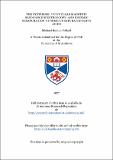Files in this item
The synthesis, ¹³C nuclear magnetic resonance spectroscopy, and enzymic desaturation of some unsaturated fatty acids
Item metadata
| dc.contributor.advisor | Gunstone, F. D. | |
| dc.contributor.author | Pollard, Michael Roman | |
| dc.coverage.spatial | 265 p. | en_US |
| dc.date.accessioned | 2018-06-18T10:35:49Z | |
| dc.date.available | 2018-06-18T10:35:49Z | |
| dc.date.issued | 1977 | |
| dc.identifier.uri | https://hdl.handle.net/10023/14179 | |
| dc.description.abstract | A wide range of [1-14C] monoenoic (32) and polyenoic (8) fatty acids and two unlabelled fatty acids containing a 6,7-cyclopropene ring were prepared by existing methods. Several procedures for the conversion of oleic acid to its C17 iodide with concomitant decarboxylation were investigated without success. The CMR spectra of (27) saturated, (65) cis and trans monoenoic, (39) monoynoic, (2) cyclopropene, (20) cis-polyenoic, (14) diynoic and (10) mixed-function diunsaturated acids and methyl esters were recorded and interpreted. An empirical approach, based on the shielding and deshielding influence of functional groups on the rest of the molecule, was employed, and the assignment of 13C resonances by this method agreed with those obtained by other researchers using different methods. The shielding and deshielding effects were generally additive, except when two function groups were close together. CMR spectroscopy can be used to distinguish cis and trans olefins, locate double and triple bond positions and interpret patterns of polyunsaturation. The specificity of the mammalian desaturases was examined by incubating [1-14C] fatty acids with a rat liver microsomal preparation and analysing the products formed after one hour. The Delta9 desaturase was believed to hold its substrate by the binding of the CoA moiety at the carboxyl end and by the fit of the alkyl chain into a deep, narrow cleft, where, except at the active centre, it was constrained to take up predominantly trans conformations. This model is confirmed. Trans monoenoic acids were generally Delta9 desaturated to give as high conversions as saturated acids, and the Delta7t and Delta11t monoenoic acids gave the corresponding Delta7t9c and Delta9c11t conjugated dienes. Cis monoenoic acids, which were not expected to fit into the enzyme cleft between C(5) and C(15), were not Delta9 desaturated unless the double bond position was beyond Delta13, and even then they were much poorer substrates than stearic acid. The Delta6 desaturase shows a much wider substrate specificity than was previously anticipated. The enzyme can accommodate a wide range of substrate chain lengths (at least C14 to C22) and the Delta9 cis double bond is not obligatory for Delta6 desaturation. The model advanced for the enzyme contains two distinct features. Firstly, a region of steric constraint between C(10) and C(13) on the substrate geometry acceptable to the enzyme is proposed. Secondly, pi-bond binding sites on the enzyme surface in the C(9) to C(13) region are envisaged. Dienoic acids with a Delta9c double bond and adjacent olefinic unsaturation (Delta11- Delta13) were much better substrates than monoenoic acids or dienoic acids containing a Delta9c double bond and a second double bond beyond the Delta13 position. Therefore, to bed substrate for Delta6 desaturation the co-operative binding of two ands, separated by 0-2 methylene groups, to these Delta-binding is essential. The Delta5 desaturase also shows a wider substrate specificity than was previously anticipated. The principal feature is a high degree of chain length specificity. Within the C16-C20 range tested C20 was the optimum chain length while minimal Delta5 desaturation occurred when the chain length dropped to C16. A region of steric constraint between C(10) and C(13) on the substrate geometry acceptable to the enzyme is envisaged. However, the range of acids tested was not extensive and an evaluation of the role of Delta-bonds in substrate-enzyme binding was not possible. No Delta4 des1aturation was observed. This agreed with other studies. | en_US |
| dc.language.iso | en | en_US |
| dc.publisher | University of St Andrews | |
| dc.subject.lcc | QP751.P7 | |
| dc.subject.lcsh | Fatty acids | en |
| dc.title | The synthesis, ¹³C nuclear magnetic resonance spectroscopy, and enzymic desaturation of some unsaturated fatty acids | en_US |
| dc.type | Thesis | en_US |
| dc.contributor.sponsor | Biotechnology and Biological Sciences Research Council (Great Britain) | en_US |
| dc.type.qualificationlevel | Doctoral | en_US |
| dc.type.qualificationname | PhD Doctor of Philosophy | en_US |
| dc.publisher.institution | The University of St Andrews | en_US |
This item appears in the following Collection(s)
Items in the St Andrews Research Repository are protected by copyright, with all rights reserved, unless otherwise indicated.

